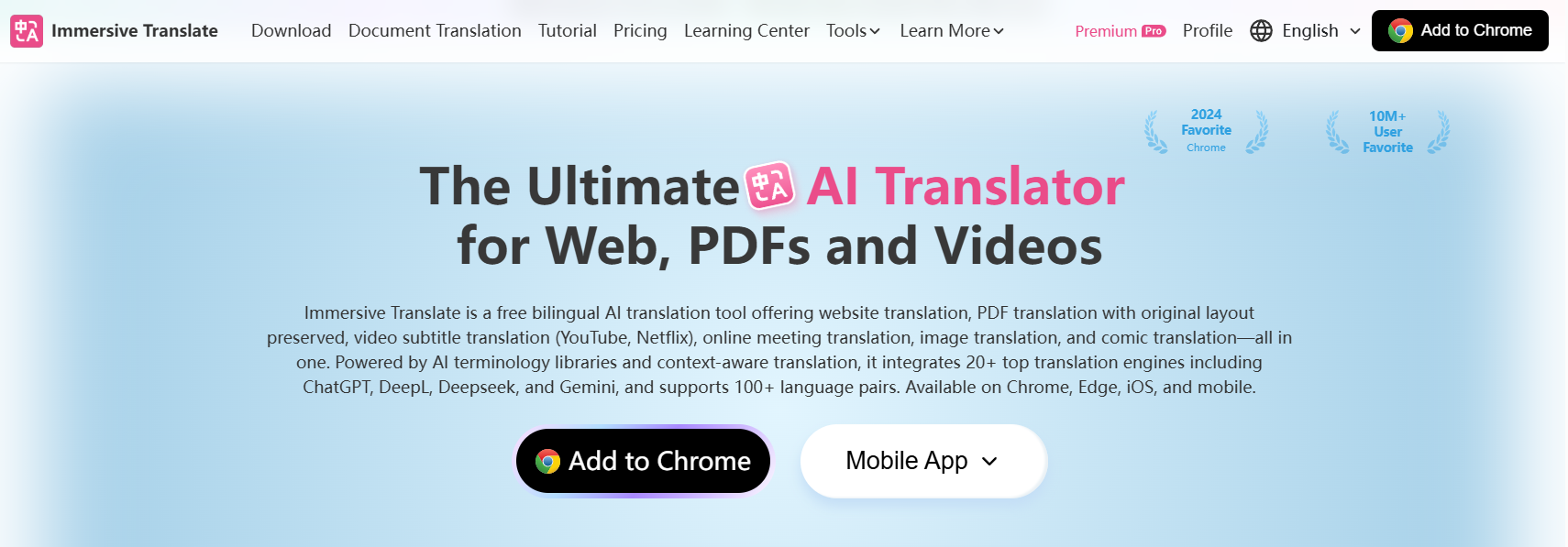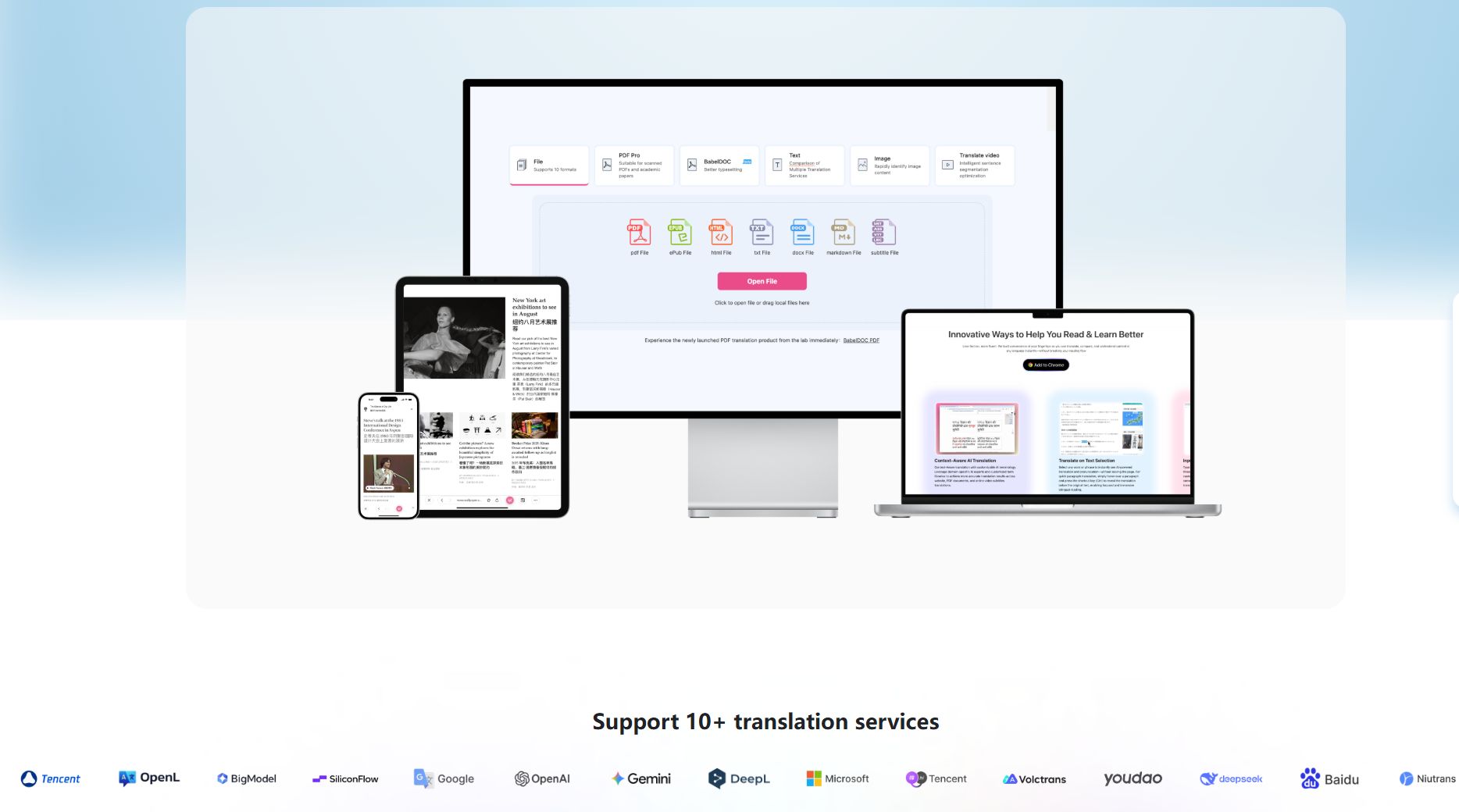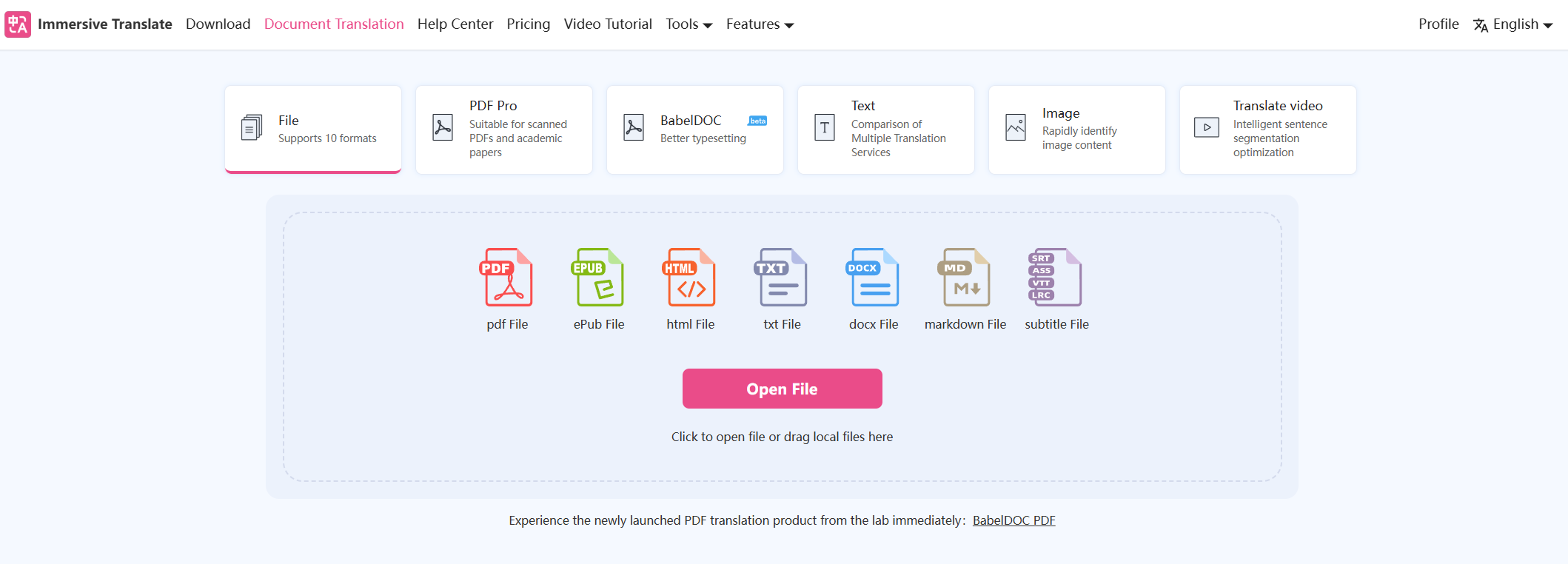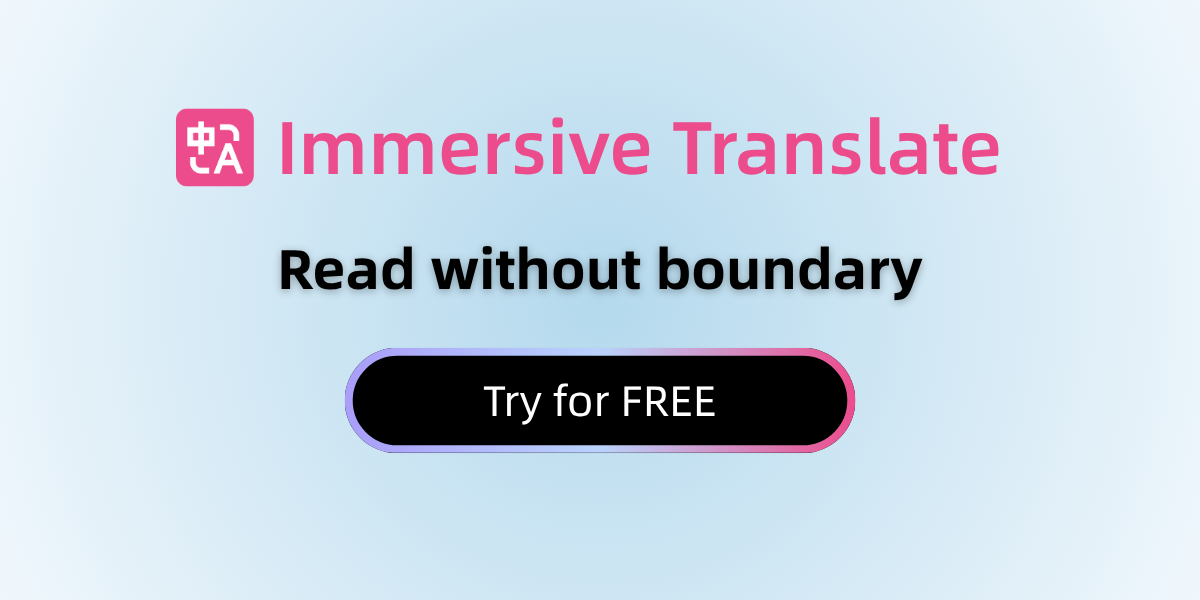Why Is Immersive Translate Revolutionizing How We Translate Long Text?
In our increasingly globalized digital landscape, the need to accurately translate long text has become more pressing than ever. Students, researchers, professionals, and casual readers alike regularly encounter lengthy foreign-language content - from academic papers and technical documentation to business reports and literary works. While many turn to Google Translate for long text as their first resort, most quickly discover its limitations for serious, extended reading. This comprehensive guide explores why Immersive Translate has emerged as the premier solution for long-form translation needs, offering features that go far beyond conventional machine translation tools.

The Growing Need for Effective Long Text Translation
The digital revolution has dramatically increased our exposure to international content. According to recent studies, non-English content now constitutes nearly 60% of all web material, while academic research shows that professionals spend an average of 3-5 hours weekly reading materials in foreign languages. This surge in cross-language consumption has created an unprecedented demand for reliable translation tools that can handle extended documents without sacrificing accuracy or readability.

Traditional approaches to translate long text have typically involved either manual translation (time-consuming and expensive) or basic machine translation (fast but unreliable). The emergence of sophisticated AI-powered tools like Immersive Translate represents a third path: combining the speed of machine translation with the nuance and accuracy that approaching human-level understanding.
Understanding the Limitations of Conventional Tools
Most users initially turn to Google Translate long text processing capabilities when facing extended foreign-language content. While Google's service has improved significantly over the years, it remains fundamentally limited for serious reading and research purposes. The primary issue lies in its complete replacement approach - the original text disappears entirely, making it impossible to:
Verify translation accuracy for technical or specialized terminology
Learn from the translation to improve language skills
Maintain reference to the original phrasing and structure
Preserve complex formatting and layout elements
Similar limitations affect other mainstream translation tools, leaving users frustrated when trying to use them as a long text translator for professional or academic purposes. The problem compounds with particularly lengthy documents, where consistency across thousands of words becomes challenging for basic translation algorithms.
What Makes Immersive Translate Different?
Immersive Translate represents a paradigm shift in how we approach translation technology. Rather than simply converting text from one language to another, it creates a bilingual reading environment that preserves the original while providing immediate, accurate translation. This dual-perspective approach has proven particularly valuable for:
Knowledge Workers
Researchers, analysts, and subject matter experts who need to reference original source material while understanding the content in their native language. For these users, the ability to quickly toggle between original and translated text is invaluable for maintaining accuracy in their work.
Language Learners
Students and self-learners who use translation not just for comprehension but as a tool for language acquisition. The side-by-side display allows them to compare structures, learn vocabulary in context, and gradually reduce their reliance on translation over time.
Global Professionals
Business professionals working across international markets who need to understand lengthy documents like contracts, reports, and proposals while maintaining access to the original wording for legal and precision purposes.
Deep Dive: Key Features That Make Immersive Translate the Best Translator for Long Texts
Advanced Bilingual Display Technology
Unlike conventional translation tools that replace content, Immersive Translate's sophisticated rendering engine maintains the original document structure while seamlessly integrating translations. Users can choose between several viewing modes:

- Paragraph-by-paragraph alternation between original and translation
- Side-by-side parallel columns for direct comparison
- Toggle functionality to instantly switch between original and translated views
This flexibility makes it significantly more useful than standard google translate for long text, particularly for complex documents where layout and structure matter as much as the content itself.
Multi-Engine Translation Capability
While Immersive Translate integrates Google Translate long text processing functionality, it doesn't stop there. The platform aggregates multiple translation engines, allowing users to select the most appropriate service for their specific needs:

- Google Translate for general content and language pairs
- DeepL for European languages with nuanced phrasing
- Microsoft Translator for technical and business content
- OpenAI's GPT for context-aware translations that better capture tone and style
- Baidu Translate for Asian language pairs
- Many other translation engines waiting for you to choose.
This multi-engine approach ensures that users always have access to the best possible translation quality, rather than being locked into a single system's strengths and weaknesses.
Comprehensive Format Support
Traditional web-based translators typically struggle with anything beyond plain text. Immersive Translate excels as a long text translator across multiple formats:

- Web pages (with intelligent element detection)
- PDF documents (including scanned and image-based PDFs via OCR)
- EPUB and other ebook formats
- Microsoft Office documents
- Plain text files with various encodings
This versatility means users can maintain a consistent translation experience regardless of the source material's format, eliminating the need to switch between different tools for different file types.
Seamless Cross-Platform Experience
Unlike many translation tools limited to specific environments, Immersive Translate provides a consistent experience across:

- Browser extensions (Chrome, Firefox, Edge, Safari)
- Mobile devices (iOS and Android)
- Desktop (Windows and macOS)
This ecosystem approach ensures that users can maintain their translation workflow regardless of device or location.
Comparative Analysis: Immersive Translate vs. Google Translate for Long Text
To understand why Immersive Translate stands out as the best translator for long texts, it's helpful to compare its capabilities directly with the most widely known alternative:
Document Length Handling
While Google Translate long text processing capability tops out at approximately 5,000 characters per translation, Immersive Translate handles documents of virtually unlimited length through intelligent segmentation and context preservation. This makes it far more suitable for book-length translation projects.
Format Preservation
Google Translate typically strips away original formatting, images, and structural elements. Immersive Translate maintains these crucial components, ensuring that the translated document remains usable for its intended purpose.
Learning and Reference Value
The fundamental difference in approach - replacement vs. enhancement - means that Immersive Translate provides ongoing value for language learners and professionals who need to reference source material, while google translate for long text serves primarily as a one-time comprehension tool.
Customization and Control
Immersive Translate users can fine-tune everything from translation engine selection to display preferences, while Google Translate offers minimal customization options for serious translation work.
Real-World Applications and Use Cases
Academic Research
Graduate student Maria Rodriguez shares: "I regularly need to review Japanese academic papers for my research. Using Google Translate for long text left me constantly worried about mistranslated technical terms. With Immersive Translate, I can quickly verify questionable translations against the original text, and the consistent terminology handling has been invaluable."
Corporate Documentation
Global IT manager David Chen notes: "Our team frequently works with lengthy technical specifications in German. The bilingual display in Immersive Translate has dramatically reduced miscommunication, and the ability to create custom glossaries for our industry terminology has improved translation consistency by at least 50% compared to standard Google Translate long text processing approaches."
Language Learning
French student Sophie Williams explains: "I'm trying to improve my Spanish by reading Latin American literature. Before finding Immersive Translate, I'd constantly switch between the original book and a separate translation app. Now I can read fluidly while checking translations only when needed. It's like having a personal tutor guiding me through difficult passages."
Implementation Guide: Getting the Most from Immersive Translate
Optimizing Settings for Different Content Types
The flexibility of Immersive Translate means that optimal settings vary by use case:
l For technical documents: Enable terminology consistency and select DeepL or specialized engines
- For literary content: Choose context-aware engines like GPT and enable natural phrasing options
- For language learning: Maximize display contrast between original and translation
- For quick reference: Set up hotkeys for rapid translation toggling
Workflow Integration Tips
Successful users typically integrate Immersive Translate into their existing workflows:
- Researchers often use it alongside reference management software
- Professionals incorporate it into their document review processes
- Students combine it with note-taking apps for efficient study sessions
The Future of Long Text Translation
As translation technology continues evolving, several trends suggest that tools like Immersive Translate represent the future of cross-language communication:
Context-Aware Translation
Next-generation systems are moving beyond sentence-level translation to document-level context understanding, dramatically improving consistency and accuracy across lengthy texts.
Personalization Through AI
Machine learning algorithms increasingly adapt to individual user preferences and specialized terminology needs.
Integrated Language Learning
The line between translation tools and language learning platforms continues to blur, with systems providing increasingly sophisticated support for skill development.
Conclusion: Why Immersive Translate Is the Best Translator for Long Texts
In the crowded landscape of translation tools, Immersive Translate stands out as the optimal solution for anyone regularly needing to translate long text. Its unique combination of bilingual display, multi-engine support, format flexibility, and user-centric design addresses the fundamental limitations of conventional tools like Google Translate for long text.
Whether you're a researcher needing accurate technical translations, a student learning through foreign texts, or a professional working across language barriers, Immersive Translate provides the accuracy, control, and usability that modern multilingual communication demands.
The tool's philosophy - that translation should enhance rather than replace the original - represents a fundamental advancement in how we approach cross-language understanding. By preserving the source material while making it accessible, Immersive Translate respects both the content and the user's intelligence.
As digital globalization continues accelerating, tools that bridge language gaps without sacrificing nuance or accuracy will only grow in importance. Immersive Translate isn't just another long text translator - it's a comprehensive solution for serious readers in our increasingly connected world.
For those ready to move beyond the limitations of basic machine translation, Immersive Translate offers a sophisticated, powerful platform that transforms how we engage with foreign-language content. The question isn't whether you need a better way to translate long text - it's how much time and accuracy you're losing by sticking with conventional tools.
